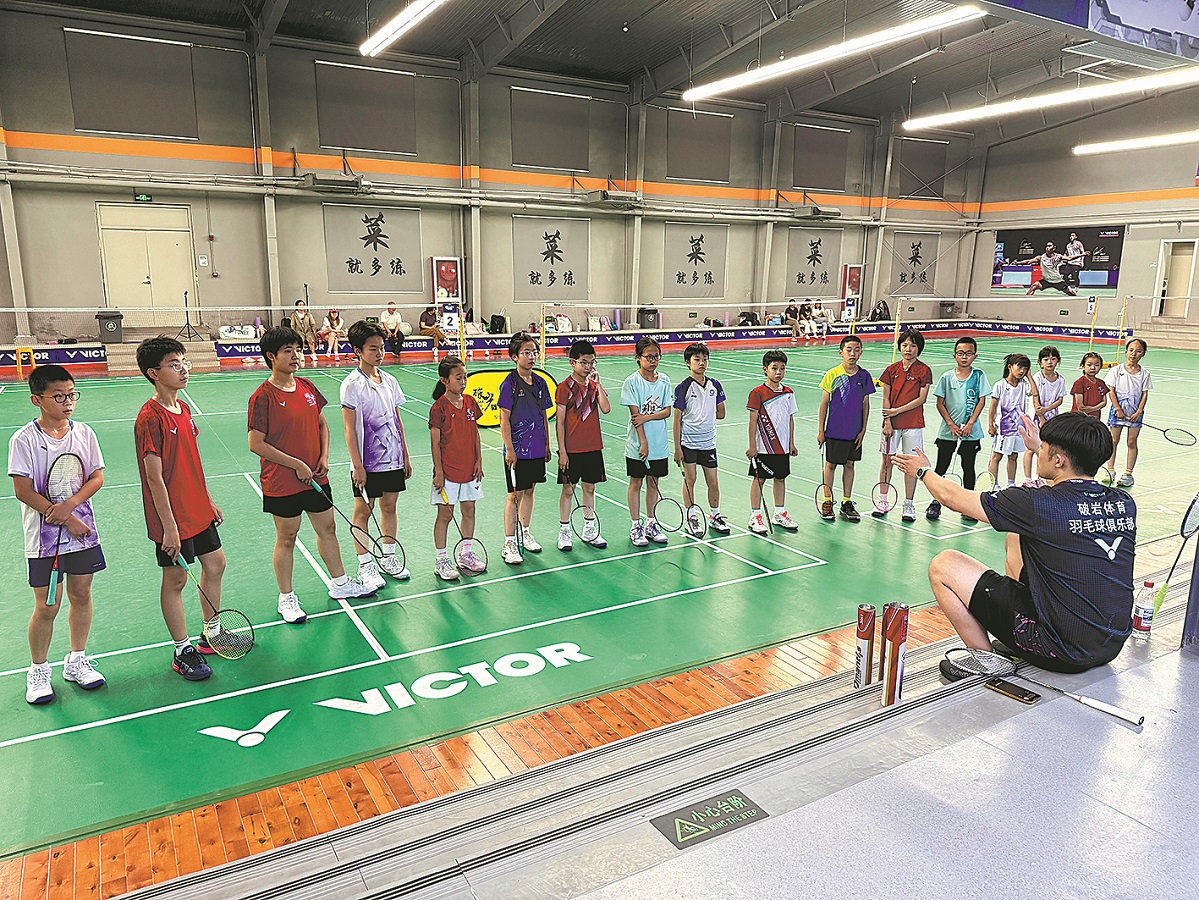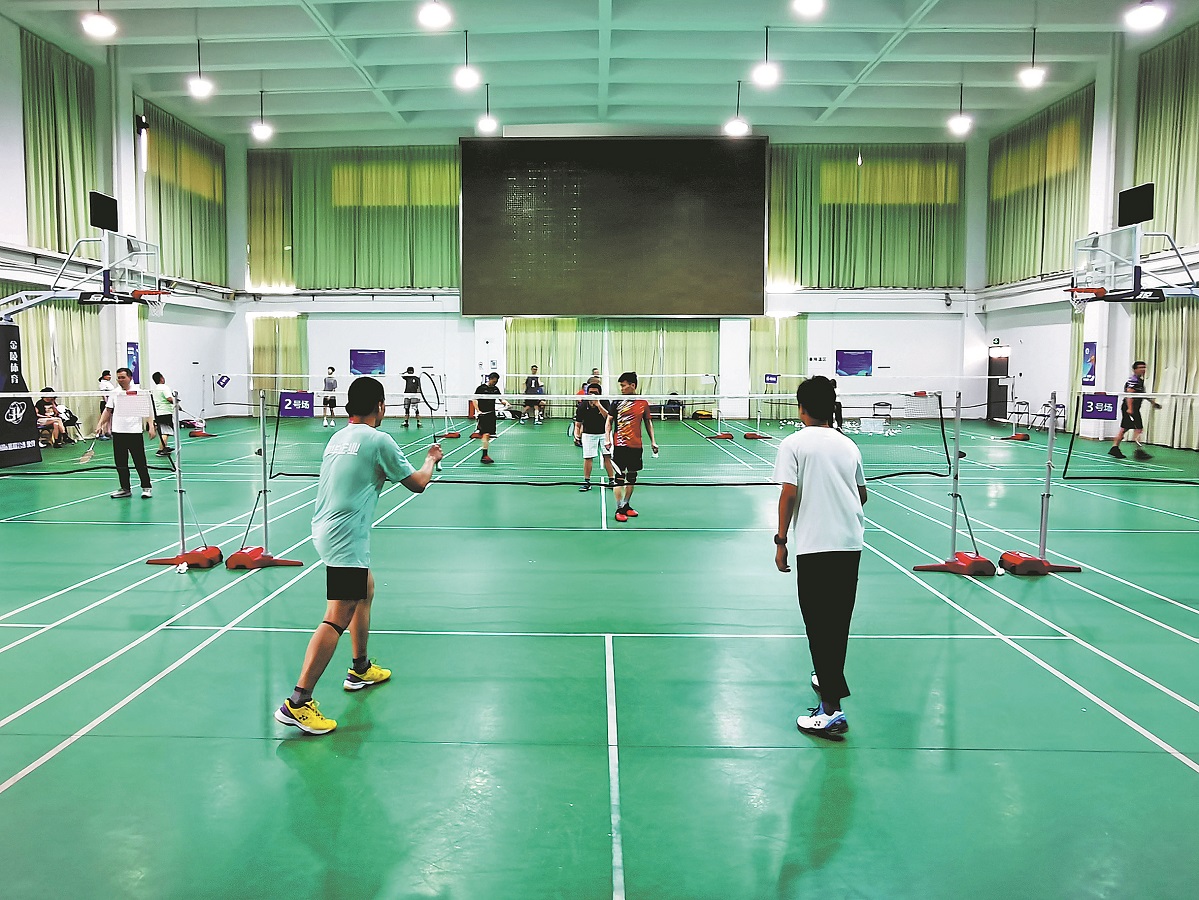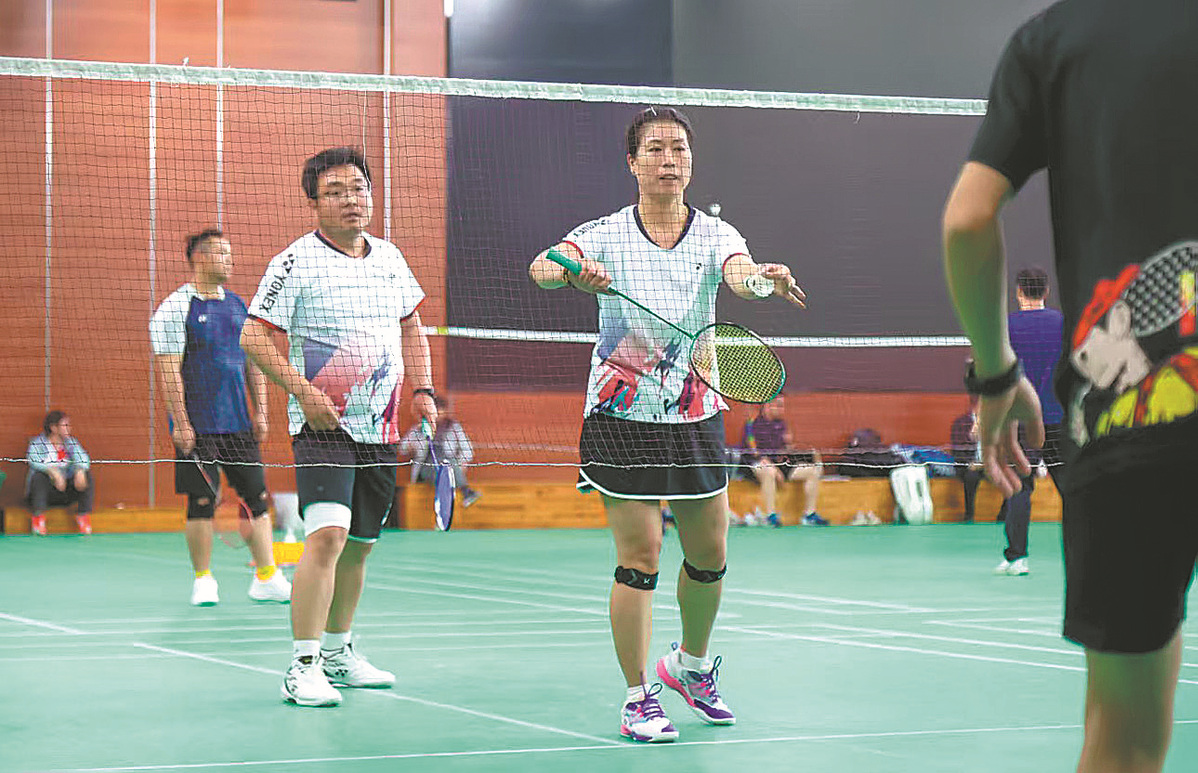
Badminton players cheer each other on during an amateur competition in Beijing. [Photo provided to China Daily]
The moment Li Yaxi saw the notice of a price hike for shuttlecocks in mid-March, her heart sank. She immediately contacted her suppliers while calculating her cash flow.
"We moved as quickly as we could to prepare the money and grab all the supplies we could get our hands on," said Li, who runs six badminton training centers in Beijing under her company Poyan Sports' umbrella. Her company has been training young badminton players since 2017.
Each tube of midrange shuttlecocks costs 70 to 80 yuan ($9.70 to $11.10). With her players training up to 18 hours a week — many of them play six hours a day on weekends — the costs pile up quickly.
"We spend 100,000 to 200,000 yuan out of our own pocket every year to support the competitive classes (of players), and about 80 percent of that goes to shuttlecocks," she said.
Since her business requires a lot of shuttlecocks, she has been buying them in bulk, normally 30 to 50 cases, with each containing 50 pieces.
"Even a slight increase of 2 to 3 percent will incur thousands of yuan in extra costs for us," she said.
At the end of March, citing a rise in raw material costs, leading badminton brand Victor announced a shuttlecock price hike to take effect after April 1.
Another major brand, RSL, has raised prices multiple times this year. After an increase at the beginning of 2025, prices were lifted again in March. On RSL's official Tmall flagship store, a tube of 12 of its No 7 shuttlecocks reached 145 yuan. Two years earlier, the same product was 74 yuan, almost half the price.
Li, who managed to secure 30 cases of shuttlecocks, can't remember the exact number of price hikes in recent years as they've been so frequent. "We wanted to buy more, but it turned out that there were not enough for us to buy," she said.

Children attend a badminton class at one of Li Yaxi's training centers in Beijing. [Photo provided to China Daily]
Price stings
Badminton is the country's most popular sport, with a staggering 250 million recreational players, according to the 2023 national sports participation survey released by the General Administration of Sport of China.
Zhao Xingluo, who organizes a big group of 2,000 recreational badminton players in Beijing, said they have carried the brunt of each major price jump over the past two years.
He once favored the popular RSL brand, with each tube of shuttlecocks costing 77 or 78 yuan, before they doubled in price to about 150 yuan.
"Prices used to climb slowly, just one yuan or so per year. But two years ago, they jumped more than 20 yuan all at once. That's when we realized something serious was happening," said 30-something Zhao. In response, he and his group of players switched to domestic brands like Li-Ning, hoping they'd be less affected by price volatility.
"We thought the price hikes were just on imported brands," he said. "But not long after, Li-Ning's prices rose too. That's when we realized it wasn't about the brand — it was the whole industry," he said.
Zhao arranges groups of 30 to 60 badminton enthusiasts to have three to four sessions on a regular basis each week in gyms across the city. "We burn through a dozen tubes of shuttles every night," he said. "And now, each tube costs way more than it used to."
With the group using more than 70 tubes a week, the expense quickly adds up.
"That's nearly more than 13,000 yuan per week, just on shuttlecocks," Zhao noted. "We split the cost among members, but it still affects how often some people choose to play, especially beginners."
Today, many of the higher-end shuttlecocks on the market, like the Chao Pai's Deep Pink series that Zhao's players now use, are priced at about 175 yuan a tube. "We choose them because they're more durable and give you a better playing experience, and thus better cost performance. But let's be honest, it still stings," he said.

Enthusiasts play with their friends at a weekend social game in Shanghai. LU PING/CHINA DAILY
Growth in venues
The number of badminton venues has surged significantly across eight major Chinese cities, according to the 2023 badminton venue industry report released by the Guangdong-based sports venue booking platform Quyundong.
The cities are Beijing, Shanghai, Tianjin, Guangzhou and Shenzhen in Guangdong province, Wuhan in Hubei province, Hangzhou, Zhejiang province, and Nanjing, Jiangsu province.
By December 2023, they had a combined total of 1,689 badminton venues, representing a 34 percent increase from 1,263 venues in December 2022, the platform reported.
Despite this rapid expansion, demand still outpaces supply nationwide. Data from the General Administration of Sport in 2023 showed that the total number of badminton courts nationwide stood at approximately 277,900 — far fewer than those for basketball and table tennis. The vast majority of these courts are outdoors, with indoor courts accounting for just 13.8 percent of the total.
In Beijing, Li Yaxi is banking on the growth of the sport. Her latest badminton training center, Caijiuduolian, opened in February in the southern part of the capital, tucked inside what was once a derelict factory.
"We started with nothing but four steel columns," Li said, recalling the condition of the old factory space before her team rebuilt it into a professional-standard training venue. The center's main goal is to find and develop youth athletes, ranging in age from 6 to 15.
The facility features five professional courts, with sports flooring and wooden under structures, specialized side lighting, a gym, a recovery center, and even a rest area where students can do homework and eat between sessions.
"It's not just a business for us. There's a lot of emotion in it," she explained about her latest business venture.
"Success is measured by results. If you can take a kid and turn them into a champion, it is not only a source of pride but also a magnet for new students," she said.
The center also rents courts to amateurs when they're not in use by students to make the space more accessible to the public and help offset operating costs.
The venue hosts five to six weekly group sessions attracting 150 participants to fill off-peak slots, which Li describes as "not bad" for a new facility.

Badminton players take part in a club competition in Shanghai. [Photo provided to China Daily]
Ducks versus demand
The price of shuttlecocks will continue to increase unless synthetic shuttlecock technology improves or the poultry industry produces more ducks that are raised through traditional 75-day farming methods, said Wang Haijun, manager of Beijing Tianyuan Qikang Sports Products Co.
Today's fast-grown ducks don't yield usable feathers, he explained. "It's not just shuttlecocks, the price of badminton products like rackets, started climbing noticeably after pandemic restrictions were lifted in 2023," he added.
Wang's company distributes equipment for major brands including Yonex. He attributes the badminton boom to people becoming more health-conscious after the pandemic.
His company's annual sales have jumped from 500 million yuan before the pandemic to nearly 800 million yuan today, with badminton products leading the expansion over tennis and basketball equipment.
However, manufacturers have struggled to keep up with demand. "While player numbers may have doubled, factory capacity has only increased by 15 to 20 percent at best," Wang explained.
The badminton industry is not self-contained and relies heavily on the poultry sector for raw materials.
According to the Badminton World Federation, the feathers used in shuttlecock production — known as "blade feathers" — come from the fourth to tenth feathers on the wings of geese and ducks. Each of these birds yields about 14 usable blade feathers, and because the curvature of feathers differs between left and right wings, crafting a single high-quality shuttlecock typically requires feathers from two to three birds from the same side, according to experts.
This quirky production demand has been compounded by market fluctuations in the pork and poultry industries in recent years.
In 2023, an oversupply of pork led to a drop in pork prices, which in turn suppressed demand for goose and duck meat.
The commercial supply of ducks declined from over 4.87 billion in 2019 to an estimated 4.22 billion in 2024, according to the China Animal Agriculture Association. Similarly, the commercial supply of geese fell from 634 million to 569 million over the same period.
This contraction in supply directly impacted feather availability, driving up prices. The wholesale price of blade feathers rose from around 200 yuan per jin (500 grams) in 2023 to 300 yuan per jin in 2024.
Soaring consumer demand and tightening raw material supplies joined hands to steadily push shuttlecock prices higher.
 Editor:Qiu Xiaochen
Editor:Qiu Xiaochen